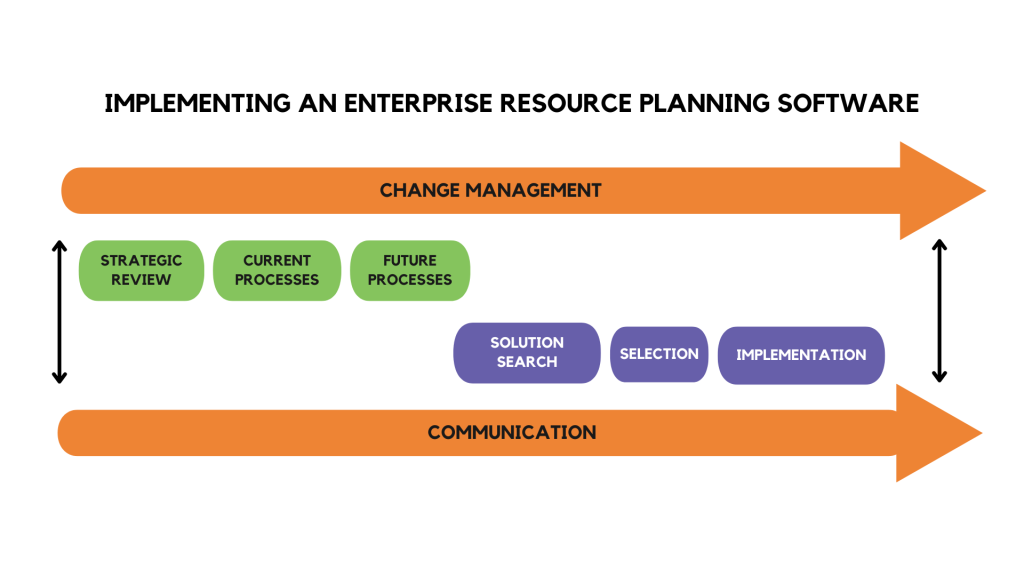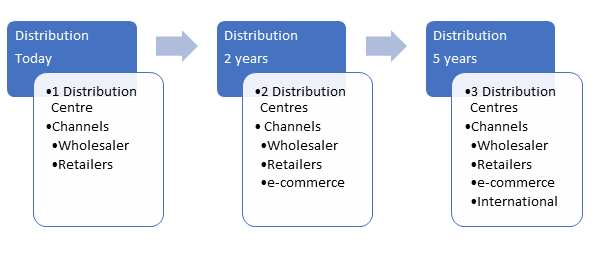
Watching your business develop and grow is fantastic! Choosing the right Enterprise Resource Planning Software (ERP is an important part of managing your growth. That way, you can offer your teams the right tools to share the right information at the right time!
Take the case of a company whose IT system no longer meets its needs. How do you choose THE right software? It’s not easy to start looking when we also must continue managing our operations. That’s why knowing your needs and activities is critical to making the right choices and investing in the right place.
Why add an ERP?
There are many reasons why you might need to add or replace an ERP package: business growth, new distribution channels, new products, or simply replacing Excel.
Whatever the reasons, certain key elements will increase the success rate of all the work leading up to the transformation because they will have an impact on your team’s day-to-day work. These include
- Helping to share critical information throughout the organisation.
- Increasing the accessibility of data for rapid decision-making.
- Adapting processes to enable better communication with customers and external partners.
- Review the behaviour required in performance management in relation to the new tools.
- Reduce the need for multiple tools and data in different applications.
Selecting an ERP requires several steps
Making such a change requires a whole process. Here are a few recommended steps for finding a new management software package.
Before you even start working on the subsequent steps, it’s a good idea to appoint someone to be in charge of the project. You know, when everyone is in charge, no one is in charge! So appointing someone to oversee the project, involve the necessary people, work with external partners, report on progress and communicate with teams and managers is the first step.

Fig1-Process of implementing an ERP Software
Change management
When should you start managing change? As soon as you start thinking about it! If we want to align all our efforts in the same direction, it is essential that change management is the first and last stage of digital transformation, and that it is present throughout the project.
Bringing about change in a company is not without its challenges. In fact, a study published in December 2021 shows that more than 70% of companies that embark on digital transformations fail to improve organisational performance or ensure the sustainability of their efforts. (1)
Why are we making this change?
Strategic change management is therefore essential to the success of this transformation. It all starts with answering a simple question: “Why?
The answer, of course, is not so simple. Managers need to take the time to reflect on this question so that they can explain to everyone why the new management software package is needed, what the objectives are, and create a sense of urgency to get everyone on board. The shared message, the story of change, needs to be the same from all managers, concise and easy to understand to engage the whole team in this digital transformation.
Stakeholders analysis
Some people will be more likely than others to embark on this transformation quickly. Taking the time to analyse possible reactions, identifying the people or groups who are most likely to resist and their reasons for doing so, will enable you to prepare responses and approaches to make them aware of the importance of this transformation. It will also be important to take the time to listen to these reasons, understand them and address them, if necessary. This will also uncover elements or even ideas that were not thought of earlier. This resistance could prove to be a goldmine of important and relevant information.
Communication
The entire management team, from executives to supervisors, has a responsibility to continually communicate the reasons for adopting the management software package, to listen to employees’ comments and ideas, to reassure and motivate stakeholders and to encourage new ideas and ways of working. Change management is a team sport!
What’s more, today’s various means of communication will have a role to play in delivering the key messages. Face-to-face team meetings are an excellent way of sharing the story of the transformation and, above all, of answering questions and reassuring people. But digital communications (for example, personalised messages to everyone, videos on the intranet and virtual meetings) can also add to the importance of the project and help to further reinforce the objectives and employee commitment.
This hybrid mode of communication will enable a common message to be shared with all stakeholders, for example:
- the timetable, objectives and progress of the transformation
- the initiatives underway to achieve the implementation plan
- the changes to strategy brought about by the new technology, and
- the contribution of technology to the achievement of strategic objectives.
Strategic review
Once you have drawn up your strategy for the company, go through the latest strategic choices with a fine-tooth comb, growth objectives (target customer base, targeted sectors of activity, distribution channels, etc.), competitive advantages, obstacles to growth, customer satisfaction studies (and their needs) and any other elements essential to the analysis. Above all, it is necessary to understand the gap between the company as it is today and where it will be in a few years’ time.

Fig2 – Distribution company example
Understanding current processes
The next step is to take stock of current processes and identify areas for improvement. This stage is carried out using process mapping workshops in which all the players from the various departments involved take part in order to gain a better understanding of the needs to be met and the estimated savings. See the article “Process mapping“.
Defining future processes
After this analysis, we also need to add future needs. This exercise requires us to project ourselves into the future and see what needs to be adapted to the company’s new situation and to the strategies put in place to grow the organisation.
This is how current and future needs and requirements can be identified. For example, in Figure 1, the current need is to be able to control one warehouse, but in two years’ time we want to be able to add a second warehouse and then a third.
Searching for ERP solutions
With all these requirements in mind, we enter the solution-finding phase. This is obviously the longest stage!
The search includes
- Finding solutions available on the market that meet current and future needs.
- Finding subsidies to help with acquisition.
- Preparing the material to send out requests for information.
- Analysing the data obtained.
- Writing and presenting a report for decision-making purposes.
With the suggested solutions, we can draw up a list of suppliers who offer the product/service we need. After analysing the various proposals received and establishing a cost estimate for each, we can schedule meetings with the selected companies to demonstrate their software.
ERP selection
Thanks to this exhaustive study, the company can choose the product that best suits its needs!
Software integrators generally offer implementation support. They will be able to train employees, share training modules and help transfer data from the previous system to the new one.
Implementation of ERP
Now that the strategy and the choice of software have been made, the work is not over! We need to put into action the next stages of communication, training and follow-up to ensure that communication continues throughout the implementation process.
To equip the whole team as quickly as possible for the digital transformation, it is essential to put in place a few elements that will help with the adoption of the new tools:
- Make information accessible to everyone,
- Revise standard procedures to include the new tools,
- Create training material, in the form of documents or videos, to help people adopt the new practices more quickly,
- Appoint great users who can share their knowledge and help their colleagues,
- Offer training courses
- Set up performance indicators to measure the adoption of the new technology.
- Review the business processes that will be impacted by the new software transactions.
Yes, such an implementation requires a great deal of preparation in terms of documentation, but also training. This major conversion in operations could lead to considerable destabilisation among employees, resulting in a drop in confidence, a loss of motivation or even the departure of certain members of staff.
A well-planned, supervised implementation, using tried and tested change and project management tools, can anticipate the risks and make this digital transformation a real success!
“To maximize digital adoption, organizations must apply the same, integrated change management and product development techniques internally as they use for customers. By adopting these methodologies, digital adoption leaders can ensure that new applications align with employee needs, help build desire ahead of implementation and incrementally transform employee mindsets.” (3)
CONTACT US TO FIND OUT MORE!
Don’t miss out on our next articles, subscribe to our newsletter!
Sources:
Photo by Tiger Lily.







